clock tower
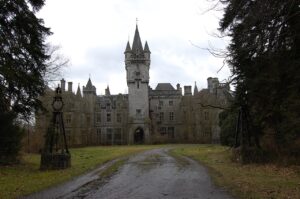
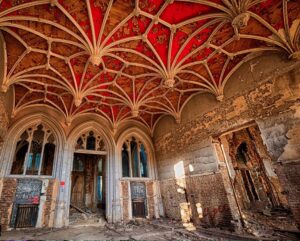 When the Liedekerke-De Beaufort family left their previous home, Vêves Castle, during the French Revolution, they needed a new home. The castle that they would name Château Miranda was planned and designed in 1866 by the English architect Edward Milner. Unfortunately, Milner died in 1884 before the château was finished. I’m sure he would have loved to see his design completed. Construction was completed in 1907 after the clock tower was erected. The descendants of the Liedekerke-De Beauford family remained in occupation until World War II. During World War II, a small portion of the Battle of the Bulge took place on the property, and it was during that time that the château was taken over and occupied by German forces.
When the Liedekerke-De Beaufort family left their previous home, Vêves Castle, during the French Revolution, they needed a new home. The castle that they would name Château Miranda was planned and designed in 1866 by the English architect Edward Milner. Unfortunately, Milner died in 1884 before the château was finished. I’m sure he would have loved to see his design completed. Construction was completed in 1907 after the clock tower was erected. The descendants of the Liedekerke-De Beauford family remained in occupation until World War II. During World War II, a small portion of the Battle of the Bulge took place on the property, and it was during that time that the château was taken over and occupied by German forces.
The Liedekerke-De Beauford never moved back into Château Miranda. In 1950, it was renamed “Château de Noisy” when it was taken over by the National Railway Company of Belgium (NMBS/SNCB). During that time, and the reason for the strange name change, was that Château Miranda was converted into an orphanage and also a holiday camp for sickly children. Château Miranda lasted as a children’s camp until the late 1970s. Little is known about its occupation from the late 19702 to 1991, when it was abandoned and stood empty, because the cost to maintain it was too great, and a search for investors in the property failed. The municipality of Celles offered to take it over, but the family refused, and the enormous building lingered in a derelict state, slowly succumbing to decay and vandalism. At one point, parts of Château Miranda were heavily damaged in a fire, and many ceiling areas began collapsing. Despite this, it became a favorite site for exploration.
Finally, the fate of Château Miranda was decided, and demolition work began in 2016. This was mainly due to concern over the structural stability of the building. The demolition took approximately a year, beginning in 
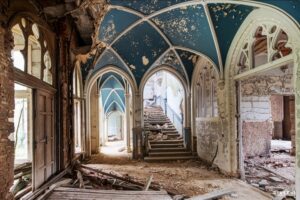 October 2016 with the removal of the roof. By October 2017, it was done…and, the Château Miranda had been completely demolished. The last part to be removed was the central tower. To me it is a terrible injustice for what was once so fine a castle. Sadly, not everyone sees the historic value in old buildings, and some would rather see these historic buildings restored, rather than have history destroyed.
October 2016 with the removal of the roof. By October 2017, it was done…and, the Château Miranda had been completely demolished. The last part to be removed was the central tower. To me it is a terrible injustice for what was once so fine a castle. Sadly, not everyone sees the historic value in old buildings, and some would rather see these historic buildings restored, rather than have history destroyed.
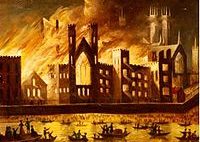
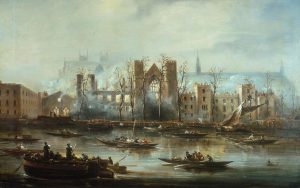 I think most people have heard of Big Ben, the famous clock tower in London, but what you may not know is that originally, there was no clock and no tower. The Houses of Parliament and Elizabeth Tower, most often called Big Ben, are among London’s most iconic landmarks and favorite London attractions. Big Ben is actually the name that was given to the massive bell inside the clock tower, which weighs more than 13 tons, not to the clock or the tower. At night the four clock faces are illuminated, and the effect is spectacular.
I think most people have heard of Big Ben, the famous clock tower in London, but what you may not know is that originally, there was no clock and no tower. The Houses of Parliament and Elizabeth Tower, most often called Big Ben, are among London’s most iconic landmarks and favorite London attractions. Big Ben is actually the name that was given to the massive bell inside the clock tower, which weighs more than 13 tons, not to the clock or the tower. At night the four clock faces are illuminated, and the effect is spectacular.
The British Parliament is located in the Palace of Westminster. In October of 1834, a fire destroyed much of the palace and it had to be rebuilt. At that time it was decided that there would be an spectacular addition of a clock at the top of a tower. The clock is magnificent. Each dial measures almost 23 feet in diameter. The hands are 14 feet long and weigh about 220 pounds, including counterweights. The numbers on the clock’s face are approximately 23 inches long. There are 312 pieces of glass in each clock dial. When parliament is in session, a special light above the clock faces is illuminated. Big Ben’s timekeeping is strictly regulated by a stack of coins placed on the huge pendulum. Big Ben has rarely stopped. Even after a bomb destroyed the Commons chamber during World War II, the clock tower survived and Big Ben continued to strike the hours. The chimes of Big Ben were first broadcast by the BBC on December 31, 1923. It is a tradition that continues to this day. The Latin words under the clock face read Domine Salvam Fac Reginam Nostram Victoriam Primam, which means “O Lord, keep safe our Queen Victoria the First.” In June 2012 the House of Commons announced that the clock tower was to be renamed the Elizabeth Tower in honor of Queen Elizabeth II’s Diamond Jubilee.
A massive bell was required and the first attempt made by John Warner and Sons at Stockton-On-Tees cracked irreparably. Big Ben first rang across Westminster on May 31, 1859. A short time later, in September 1859, Big 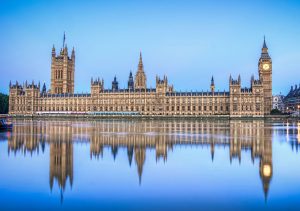
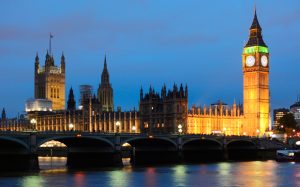 Ben cracked. The metal was melted down and the bell recast in Whitechapel in 1858. A lighter hammer was fitted and the bell rotated to present an undamaged section to the hammer. This is the bell as we hear it today, and the real owner of the name Big Ben. Elizabeth Tower stands at more than 105 yards tall, with 334 steps to climb up to the belfry and 399 steps to the Ayrton Light at the very top of the tower.
Ben cracked. The metal was melted down and the bell recast in Whitechapel in 1858. A lighter hammer was fitted and the bell rotated to present an undamaged section to the hammer. This is the bell as we hear it today, and the real owner of the name Big Ben. Elizabeth Tower stands at more than 105 yards tall, with 334 steps to climb up to the belfry and 399 steps to the Ayrton Light at the very top of the tower.

